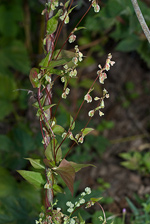|
||||||
|
FALLOPIA. Bindweeds and knotweeds. [Polygonaceae] |
|
|
Five species of Fallopia are recorded in Britain. These include the native Black-bindweed (F. convolvulus) and Copse-bindweed (F. dumetorum). The BSBI provide a downloadable plant crib for Fallopia. Three British miners are recorded on Fallopia. A key to the European miners recorded on Fallopia (incl. Reynoutria), is provided in Bladmineerders van Europa. |
|
Key for the identification of the known mines of British |
1a > Leaf-miner: Blotch mine. Broad corridor, widening into a large transparant blotch with 1 or several, proportionally very large larvae that quickly completely mine out a leaf, then move to another leaf. At the start of the first mine at the leaf underside 1 or more oval egg shells. Pupation outside the mine. Forms large blotches on leaves. |
|
Pegomya setaria (Meigen, 1826) [Diptera: Anthomyiidae]. |
1b > Leaf-miner: Large upper side blotch or blister mine, which can start with a short corridor. In small leaves the mine can be full depth in places. Often several larvae in a mine; frass irregularly scattered in large lumps. Pupation external. The mine is illustrated in British Leafminers. Large blotch, theoretically upper-surface, but often virtually full depth, often preceded by a short, broad corridor. Usually several larvae in a mine. The larvae can leave their mine and make a new one elsewhere. At the start of the first mine a small group of oval, whitish, egg shells. Pupation outside the mine. |
|
Pegomya bicolor (Wiedemann, 1817) [Diptera: Anthomyiidae]. |
1c > Leaf-miner: Initially a gallery is formed, this turning into a blotch, and later two successive conical leaf-rolls. Initially a pale, later brown, usually lower-surface blotch. The blotch is preceded by an epidermal corridor, but that may be obliterated by the later blotch. Silk at the inside of the mine causes it to buckle up a bit and fold. The reddish brown frass is accumulated in a corner of the mine. The older larva leaves the mine and continues feeding inside an untidy cone, made by cutting off a strip of leaf tissue and stitching it in place with silk. |
|
Calybites phasianipennella (Hübner, 1813) [Lepidoptera: Gracillariidae]. |
| Last updated 05-Jul-2019 Brian Pitkin | ||

